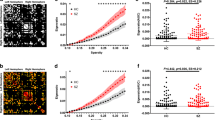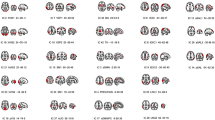Abstract
The anticorrelations in fMRI measurements are still not well characterized, but some new evidences point to a possible physiological role. We explored the topology of functional brain networks characterized by negative edgess and their possible alterations in schizophrenia, using functional images of 8 healthy subjects and 8 schizophrenic patients in a resting state condition. In order to minimize the insertion of artifactual negative correlations, the preprocessing of images was carried out by the CompCorr procedure, and the results compared with the Global Signal Regression (GSR) procedure. The degree distribution, the centrality, the efficiency and the rich-club behavior were used to characterize the functional brain network with negative links of healthy controls in comparison with schizophrenic patients. The results show that functional brain networks with both positive and negative values have a truncated power-law degree distribution. Moreover, although functional brain networks characterized by negative values have not small-world topology, they show a specific disassortative configuration: the more connected nodes tend to have fewer connections between them. This feature is lost using the GSR procedure. Finally, the comparison with schizophrenic patients showed a decreased (local and global) efficiency associated to a decreased connectivity among central nodes. As a conclusion, functional brain networks characterized by negative values, despite lacking a well defined topology, show specific features, different from random, and indicate an implication in the alterations associated to schizophrenia.





Similar content being viewed by others
References
Achard, S., Salvador, R., Whitcher, B., Suckling, J., & Bullmore, E. (2006). A resilient, low-frequency, small-world human functional brain network with highly connected association cortical hubs. The Journal of Neuroscience, 26(1), 63–72.
Anticevic, A., Gancsos, M., Murray, J. D., Repovs, G., Driesen, N. R., Ennis, D. J., Niciu, M. J., Morgan, P. T., Surti, T. S., Bloch, M. H., Ramani, R., Smith, M. A., Wang, X. J., Krystal, J. H., & Corlett, P. R. (2012). Nmda receptor function in large-scale anticorrelated neural systems with implications for cognition and schizophrenia. Proceedings of the National Academy of Sciences of the United States of America, 109(41), 16720–16725.
Behzadi, Y., Restom, K., Liau, J., & Liu, T. T. (2007). A component based noised correction method (CompCor) for BOLD and perfusion based fMRI. NeuroImage, 37(1), 90–101.
Chai, X. J., Castanon, A. N., Ongur, D., & Whitfield-Gabrieli, S. (2012). Anti-correlations in resting state networks without global signal regression. NeuroImage, 59(2), 1420–1428.
Chai, X. J., Ofen, N., Gabrieli, J. D., & Whitfield-Gabrieli, S. (2014). Selective development of anticorrelated networks in the intrinsic functional organization of the human brain. Journal of Cognitive Neuroscience, 26(3), 501–513.
Chang, C., & Glover, G. H. (2009). Effects of model-based physiological noise correction on default mode network anti-correlations and correlations. NeuroImage, 447(4), 1448–1459.
Chen, G., Chen, G., Xie, C., & Li, S. J. (2011). Negative functional connectivity and its dependence on the shortest path length of positive network in the resting-state human brain. Brain Connectivity, 1(3), 195–206.
Di, X., & Biswal, B. B. (2013). Modulatory interactions of resting-state brain functional connectivity. PloS One, 8(8), e71163.
Fox, M. D., Snyder, A. Z., Vincent, J. L., Corbetta, M., Van Essen, D. C., & Raichle, M. E. (2005). The human brain is intrinsically organized into dynamic, anticorrelated functional networks. Proc Natl Acad Sci USA, 102(27), 9673–9678.
Fox, M. D., Zhang, D., Snyder, A. Z., & Raichle, M. E. (2009). The global signal and observed anticorrelated resting state brain networks. Journal of Neurophysiology, 101(6), 3270–3328.
Fransson, P. (2005). Spontaneous low-frequency bold signal fluctuations: An fmri investigation ofthe resting-state default mode of brain function hypothesis. Hum. Brain Mapp, 26, 15–29.
Friston, K. J. (2011). Functional and effective connectivity: A review. Brain Connectivity, 1, 13–36.
Glickman, M. E., Rao, S. R., & Schultz, M. R. (2014). False discovery rate control is a recommended alternative to bonferroni-type adjustments in health studies. Journal of Clinical Epidemiology, 67(8), 850–857.
Gopinath, K., Krishnamurthy, V., Cabanban, R., & Crosson, B. A. (2015). Hubs of anticorrelation in high-resolution resting-state functional connectivity network architecture. Brain Connectivity, 5(5), 267–275.
Greicius, M. D., Krasnow, B., Reiss, A. L., & Menon, V. (2005). Functional connectivity in the resting brain: A network analysis of the default mode hypothesis. Proceedings of the National Academy of Sciences of the United States of America, 100(1), 253–258.
van den Heuvel, M. P., & Sporns, O. (2011). Rich-club organization of the human connectome. The Journal of Neuroscience, 31(44), 15775–15786.
van den Heuvel, M. P., Sporn, O., Collin, G., Scheewe, T., Mandl, R. C., Cahn, W., Goni, J., Hulshoff Pol, H. E., & Kahn, R. S. (2013). Abnormal rich club organization and functional brain dynamics in schizophrenia. JAMA Psychitry., 70(8), 783–792.
Jack, A. I., Dawson, A. J., Begany, K. L., Leckie, R. L., Barry, K. P., Ciccia, A. H., & Snyder, A. Z. (2013). Fmri reveals reciprocal inhibition between social and physical cognitive domains. NeuroImage, 66, 385–401.
Josipovic, Z., Dinstein, I., Weber, J., & Heeger, D. J. (2012). Influence of meditation on anti-correlated networks in the brain. Frontiers in Human Neuroscience, 5, 183.
Keller, C. J., Bickel, S., Honey, C. J., Groppe, D. M., Entz, L., Craddock, R. C., Lado, F. A., Kelly, C., Milham, M., & Mehta, A. D. (2013). Neurophysiological investigation of spontaneous correlated and anticorrelated fluctuations of the bold signal. The Journal of Neuroscience, 33(15), 6333–6342.
Keller, J. B., Hedden, T., Thompson, T. W., Anteraper, S. A., Gabrieli, J. D., & Whitfield-Gabrieli, S. (2015). Resting-state anticorrelations between medial and lateral prefrontal cortex: Association with working memory, aging, and individual differences. Cortex, 64, 271–280.
Lynall, M. E., Bassett, D. S., Kerwin, R., McKenna, P. J., Kitzbichler, M., Muller, U., & Bullmore, E. (2010). Functional connectivity and brain networks in schizophrenia. The Journal of Neuroscience, 30(28), 9477–9487.
Maslov, S., & Sneppen, K. (2002). Specificity and stability in topology of protein networks. Science, 296(5569), 910–913.
Murphy, R., Birn, R. M., Handwerker, D. A., Jones, T. B., & Bandettini, P. A. (2009). The impact of global signal regression on resting state correlations: Are anti-correlated networks introduced? NeuroImage, 44(1), 893–905.
Power, J. D., Barnes, K. A., Snyder, A. Z., Schlaggar, B. L., & Petersen, S. E. (2012). Spurious but systematic correlations in functional connectivity MRI networks arise from subject motion. Neuroimage. Neuroimage, 59(3), 2142–2154.
Power, J. D., Mitra, A., Laumann TO, Snyder, A. Z., Schlaggar, B. L., & Petersen, S. E. (2014). Methods to detect, characterize, and remove motion artifact in resting state fMRI. Neuroimage, 84, 320–341.
Rubinov, M., & Sporn, O. (2011). Weight-conserving characterization of complex functional brain networks. NeuroImage, 56(4), 2068–2079.
Rubinov, M., & Sporns, O. (2009). Complex network measures of brain connectivity: Uses and interpretations. NeuroImage, 53(3), 1059–1069.
Schwarz, A. J., & McGonigle, J. (2011). Negative edges and soft thresholding in complex network analysis of resting state functional connectivity data. NeuroImage, 55(3), 1132–1146.
Tian, L., Jiang, T., Liu, Y., Yu, C., Wang, K., Zhou, Y., Song, M., & Li, K. (2007). The relationship within and between the extrinsic and intrin- sic systems indicated by resting state correlational patterns of sensory cortices. NeuroImage, 36(3), 684–690.
Tzourio-Mazoyer, N., Landeau, B., Papathanassiou, D., Crivello, F., Etard, O., Delcroix, N., Mazoyer, B., & Joliot, M. (2002). Automated anatomical labeling of activations in spm using a macroscopic anatomical parcellation of the mni mri single-subject brain. NeuroImage, 15(1), 273–289.
Uddin, L. Q., Kelly, A. M., Biswal, B. B., Xavier Castellanos, F., & Milham, M. P. (2009). Functional connectivity of default mode network components: Correlation, anticorrelation, and causality. Human Brain Mapping, 30(2), 625–637.
Whitfield-Gabrieli, S., Thermenos, H. W., Milanovic, S., Tsuang, M. T., Faraone, S. V., McCarley, R. W., Shenton, M. E., Green, A. I., Nieto- Castanon, A., La Violette, P., Wojcik, J., Gabrieli, J. D., & Seidman, L. J. (2009). Hyperactivity and hyperconnectivity of the default network in schizophrenia and in first-degree relatives of persons with schizophrenia. Proceedings of the National Academy of Sciences of the United States of America, 106(4), 1279–1284.
Wong, C. W., Olafsson, V., Tal, O., & Liu, T. T. (2012). Anti-correlated networks, global signal regression, and the effects of caffeine in resting-state func- tional mri. NeuroImage, 63, 356–364.
Wotruba, D., Michels, L., Buechler, R., Metzler, S., Theodoridou, A., Gerstenberg, M., Walitza, S., Kollias, S., Rossler, W., & Heekeren, K. (2014). Aberrant coupling within and across the default mode, task-positive, and salience network in subjects at risk for psychosis. Schizophrenia Bulletin, 40(5), 1095–1104.
Author information
Authors and Affiliations
Corresponding author
Ethics declarations
Conflict of interest
The authors declare that they have no conflict of interest.
Ethical approval
All procedures performed in studies involving human participants were in accordance with the ethical standards of the institutional and/or national research committee and with the 1964 Helsinki declaration and its later amendments or comparable ethical standards.
Informed consent
Informed consent was obtained from all individual participants included in the study.
Electronic supplementary material
ESM 1
(PDF 628 kb)
Rights and permissions
About this article
Cite this article
Parente, F., Frascarelli, M., Mirigliani, A. et al. Negative functional brain networks. Brain Imaging and Behavior 12, 467–476 (2018). https://doi.org/10.1007/s11682-017-9715-x
Published:
Issue Date:
DOI: https://doi.org/10.1007/s11682-017-9715-x




